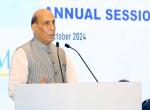On 11th Mar 11 literally the hell struck the north eastern coastal areas of Japan in the form of a devastating earthquake of 9 magnitude which triggered a powerful tsunami with 10 meter high waves which travelled 10 km inland at jet speed. It has left 4.4 million households in Northeastern Japan without electricity and about 1.4 million households without water. 450,000 people have been shifted to temporary relief shelters. As of today, the number of people dead are 10,000and reported missing are approximately 17,004. The economic losses are estimated to be a staggering amount of US$ 300 Billion plus.
The crisis in Fukushima –Daiichi reactors continues unabated and the higher radiation levels have forced authorities to order evacuation from within 12 km of the plant. The entire world is seeing in this possible nuclear crisis a repeat of Chernobyl and cannot bring itself to accept it. Already Germany has announced the shut down of its 7 oldest nuclear reactors and China has put further approvals of fresh reactors on hold.
Even in the face of this calamity, the reality is that no ‘at risk’ country in the world is better prepared than Japan to face disasters of this magnitude. We will recall that in the Indian Ocean tsunami in December 2004, over 238,000 lives were lost and in Haiti in a 7 magnitude earthquake in January 2010, over 300,000 people were killed. While it is not possible to tame the fury of 10km high sea waves moving at jet speed, the fact is that Japan has coped rather well with the earthquake risks and vulnerability. All that is because of the efficacy of the strict compliance regime of the building codes and an efficient early warning system instituted in Japan (on line
since 2007), which have restricted the damage to buildings and infrastructure and saved countless lives. The foreshocks which were picked up by the Japanese warning system gave a 90 seconds warning to people in Tokyo and saved the lives of several hundreds of thousands of people who came out into the streets and escaped to large open grounds away from falling debris.
Where does India stand in terms of preparedness?
With the 2004 Tsunami acting as the catalyst, India enacted a path breaking Disaster Management Act in 2005 and a National Disaster Management Authority at the national level headed by the Prime Minister himself and similar authorities at the state level with Chief Ministers as the Chair Persons were set up. This made available an institutional mechanism to meet disaster management requirements at all levels. It is also a fact that a substantial amount of work has been done and these authorities are functional at all levels, albeit to differing levels of efficacy. So how well is India prepared? Let us begin with the pluses first.
A state of the art Tsunami Warning Centre has already been set up at Hyderabad. A “Policy on Disaster Management” has been enunciated and released by the Prime Minister himself and over 18 elaborate Guidelines covering all natural, man made disasters and related thematic issues have been issued down to district levels for implementation. A World Bank aided Cyclone Mitigation Project, with a starting outlay of approximately Rs 1800 Crores has already been approved by the Government of India for implementation. This will provide cyclone shelters, shelter belt plantation along the coast line, a real time warning system etc in states of Andhra Pradesh, Orissa and Andaman & Nicobar island territory to start with. In the same breath, it must be mentioned that there are a large number of critical mitigation projects like for Earthquake, School Safety and fail safe communication network at national level awaiting Government approval for a long time: a time loss which, a disaster prone country like India can ill afford.
A substantial beginning has been made towards better medical preparedness but there is a long way to go. The subject of Disaster Management is going to be included shortly as a part of the educational curriculum in all types of education be it technical, scientific, medical or even agriculture. This will ultimately create a powerful cadre of millions of well informed youth in the country.
And most notably, a modern, well equipped and dedicated National Disaster Response Force of over 10,000 personnel has been operationalised (8 battalions from the four CPMF) to meet the challenges of natural disasters and credentials well proven. Shortly this number will be raised to 12 battalions and all these will be equipped and trained to handle both natural and man made disasters. And lastly requisite funds have been provided by the XIII Finance Commission to the municipalities for raising their fire fighting capabilities.
Earthquakes pose us greatest worry
Because of the twin disasters in Japan, the debate in India is now mainly focused on the safety of our nuclear plants and our possible future course with regard to the nuclear energy. The weaknesses in our cities and other infrastructures to withstand such earthquakes are being relatively overlooked. It will be a great folly. The fact is that while India is somewhat reasonably prepared to handle challenges posed by cyclones and floods and our track record in that regard is reasonable, we are in a bad shape of preparedness as far as the earthquakes are concerned.
Experts in seismology world over are generally agreed that a major earthquake in the Himalayan belt is a live possibility in the not too distant future. 229 districts (more than 1/3rd of the total in India) fall under Zones IV and V. Major cities like Guwahati and Srinagar are in Zone V, Delhi and Chandigarh in Zone IV and Kolkata, Chennai and Bombay in Zone III which reflects the high level of risks.
In disasters we need to prepare for worst case scenarios. Yet some very serious shortcomings persist in the preparedness levels because of our overall complacency towards this subject as explained subsequently.
1 : The enforcement and compliance of the earthquake-resistant building codes for the built environment and all other types of infrastructure is woefully lacking because of vested interests and needs to be improved substantially. The studies have shown that presently in case of a 7.5/8 Richter or plus magnitude earthquake scenario in a city like Delhi, tens of thousands of buildings would collapse and hundreds of thousands would face serious structural damages.
2 : While all new projects have now to necessarily go through disaster safety audit at the planning and approval stages, there is an immediate need for the structural safety audit of all old critical infrastructure facilities like dams, power supply, telecom facilities, flyovers, railway lines and railway bridges so that they can be seismically strengthened and retrofitted on priority.
3 : There is a need to expeditiously carry out risk assessment and vulnerability analysis, strengthen multi-hazard preparedness, and prepare disaster management plans at national, state, district and block levels. This exercise was commenced some time back and needs to be finished urgently and then rehearsed Army style.
4 : The fact that a large number of mitigation projects like Earthquake mitigation project, School Safety, Fail safe Communication project etc are awaiting Government approval reflects a systemic weakness. This approval system needs to be re-examined and projects given expeditious clearances bypassing the endless red tape. The financial requirements for these projects will be approximately Rs 25,000 Crores over next five years, which is really a pittance, when viewed in light of risks. It is also ironic that it is the poorer segment of the society which is the hardest hit in all types of disasters.
5 : There is also a pressing urgency of creating a reserve of stores for meeting the housing requirements of more than 3-4 lakhs displaced people in the wake of any major disaster, in terms of tentage, shelters, blankets, hygiene, water and power etc. It is difficult to procure these stores off the shelf in the short time available.
With all the above aspects seriously attended to, we are still likely to take between 10 to 15 years to reach a minimum satisfactory level in terms of preparedness for earthquakes. We can also not forget that other countries like Japan and the USA are at least thirty to forty years ahead of us in this field.
The Nuclear Energy Dilemma
What lessons can we draw from this tragedy in Japan? First, even though nuclear plants are constructed with many layers of inbuilt safety against Earthquakes of the Magnitude of 7.5 or 8 (should now be raised to 9), it is impossible for them to withstand a double onslaught of earthquake and tsunami. Two, multiple safety systems do not rule out accidents as reactors can be disabled by a single root cause, like Tsunami in the Japanese case. Despite all the inbuilt redundancies, failure of one single system like power back up in this case can become most difficult to handle. Third, problems in one reactor can add to the problems in another. In view of the above, the prompt decision of the Government to carry out a safety audit of all our nuclear plants is commendable.
However, to be of value, it should be imperative that it involves independent experts from outside the Atomic energy establishment. The current thinking of having multiple reactors at one site, as it believably makes them more economical and easier to build, also needs to be re-examined. These plants also need to be located a minimum of 10-15 Km away from the coast line. Internally, there is a need to consider providing more wherewithal to the Atomic Energy Regulatory Board (AERB) in terms of total autonomy, self sufficiency in man-power, resources and finances to be more effective. The exercise begun to enforce some measures in the wake of Mayapuri radiation incident need to be implemented without any loss of time including approved expansion of Emergency Response Centers and equipping of a large number of police stations with dosimeters in cities with over two million population.
Finally, the most important of all, we as a nation may also like to take another well considered call on the usefulness of nuclear energy, because of its attendant risks and strengthen the safety aspects in both existing and proposed nuclear installations in earthquake- and tsunami-prone areas.
Conclusion
There is no gainsaying that we are much behind the world in our levels of preparedness to meet the challenges of grave disasters especially in case of earthquakes. While the enactment of the Disaster Management Act 2005 was a much laudable pioneering step by the Government; to be result oriented, the follow up needs to be far more vigorous. We now know the path which must be traversed and the strategy stands evolved, but we need to shift to top gear to attend to preparedness deficits on crash priority to save lives. Business as usual attitude of the officialdom and non- availability of the dedicated disaster management staff at all levels (generally an addendum to revenue departments in the states) pose insurmountable problems. We need to remember that a catastrophe like this one is not only for others, it can also strike us. The clock may be already ticking!
To prepare ourselves better, the Government needs to exhibit political will to take firm decisions like enforcement of building codes, drawing up of town planning plans and implementing them. They also need to include the subject of Disaster Management in their ‘National Priority Agenda’. Finally, it is important that the Disaster Management Authorities, at all levels, are provided with genuine teeth, functional autonomy and requisite financial backup as they completely lack these today.
(Gen NC Vij is a former Chief of Army Staff and also the founder Vice Chairman of National Disaster Management Authority. He is also a distinguished fellow at Vivekananda International foundation. NVC Menon is also a founder member of the above Authority (NDMA) and a Prof. of Disaster Management).










Nice essay ..
Post new comment